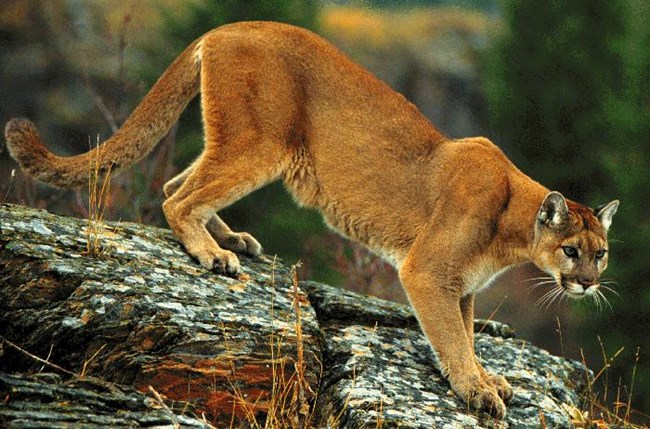
North America's Largest Wild CatThe cougar (Puma concolor), also known by several names such as mountain lion, puma, panther, or catamount, is the largest wild cat in North America. Exceptionally adaptable, cougars are found in a wide variety of environments, extending their range from the forests of Canada to the southern tip of South America. Although they favor forested areas, cougars can thrive in nearly every type of biome, making them one of the most versatile predators in the animal kingdom. Cougars rank as the fourth largest cat species in the world. Males typically reach an impressive length of 7.9 feet from head to tail, while females are slightly smaller, averaging 6.7 feet. Males also outweigh their female counterparts, averaging 137 pounds compared to 93 pounds for females. These majestic cats are easily identified by their round heads, upright ears, and sleek coats, which usually range in color from tan to golden, with a white underbelly. Their coloration is often compared to that of a lion, adding to their regal appearance. As carnivores, cougars are highly skilled predators, capable of taking down a wide range of prey, from insects and birds to large animals like deer. They typically stalk their prey silently, using their surroundings for cover before pouncing and delivering a powerful, fatal bite to the neck. Cougars are often found in areas with high deer populations and, on average, make a large kill every two weeks. These solitary animals are known to live alone, with the exception of females raising their cubs. A cougar’s territory can vary greatly depending on the region, ranging from as small as 10 square miles to as large as 500 square miles. Territorial conflicts may arise when male cougars' ranges overlap, often leading to physical confrontations as they defend their habitats. Despite their fearsome reputation, cougars generally avoid human interaction and do not view people as prey. However, it’s important to know how to react if you encounter one in the wild. If you come across a cougar, stay calm, and do not run—this can trigger the animal's instinct to chase. Instead, stand tall, make yourself appear as large as possible, and use a loud, assertive voice to scare the cougar away. In the unlikely event that a cougar attacks, fight back with anything you can find, such as sticks, rocks, or even your bare hands. Cougars are strong predators, but humans can successfully deter them through persistence and aggression. This majestic feline remains a symbol of strength and wilderness, and while it avoids human contact, knowing how to respect its space and react to encounters helps ensure a safe experience in cougar habitats. |
Last updated: September 5, 2024
